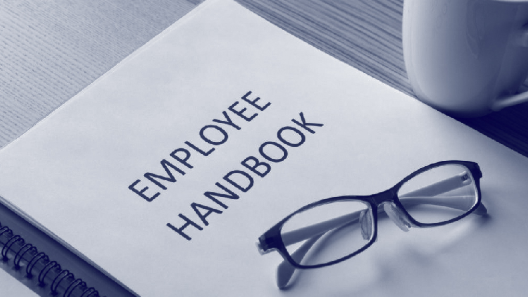An employee’s first few days at work sets more than the tone of his experience in the organization. Apart from getting the general “feel” of the organization, this is also when he learns about the company, its brand, culture and how things function. The first few weeks is an opportune time for an organization to set a framework that leads to its employees’ productivity and success.
Organizations should take the chance to make their employees feel confident and raring to contribute to their roles, and most do it with a good employee onboarding program. One of the most important things that you can do to improve your organization’s employee onboarding program is to create and distribute a good employee handbook on your new hire’s first day.
What is an Employee Handbook?

The employee handbook is a packet of information, provided digitally, in-hand, or both, to every employee in the company. It shares useful information regarding your company culture, policies, and expectations, as well as communicate any specific details pertinent to working for your company that may be unique from other employers. Many companies use the employee handbook as a tool to disseminate employment policies governed by the Employment act, and things employees will feel emotionally secure to know about, in written communication to employees.
While it is not required by law to have an employee handbook, it is good to have an official document like one to keep all the forms and information that you can document, replicate and distribute to your employees when needed.
4 ways an Effective Employee Handbook can help you & your organization
1. With a well-written, comprehensive employee handbook, employees always know what is expected of them at work
They know how their employer will address and apply the policies and procedures of the business and what they, as employees, can expect from the employer. They can have reasonable expectations that fellow employees with similar issues will receive similar treatment.
2. Establishes mutual understanding between employer and employee
As employee handbooks generally contain a code of conduct for employees with guidelines around appropriate behavior for the individual workplace, it allows the employer to know that there is mutual understanding with the employees about actions and behaviors that will warrant disciplinary action. There is thus a shared approach to addressing workplace issues.
3. A reliable guide that provides solution support to employers
In terms of legal requirements, the employee handbook provides an excellent scope of the responsibilities for an employee and an employer and forms an important part of the employment contract under the Singapore Employment Law. It sets clear expectations, providing policies for all employees to follow, and making it easier for employers to know how to work with employees to deal with problems when they arise, prevent disagreements, and even keep the company out of legal suits.
4. It improves employee morale
Employees like knowing their rights and employment benefits they are accorded to. The employee handbook also sets out the various employee benefits that are accorded to employees, which makes employees feel secure. This is great potential to create a harmonious, fair and supportive employee-employer workplace. And this also makes the employee handbook an essential part of an employee onboarding program!
Still, many companies struggle with developing an effective employee handbook. With growing importance placed on company culture, an ineffective handbook can be detrimental to the overall work environment. If you already have an employee handbook, you should ensure that it has been recently updated to comply with the constantly changing employment policies and practices.
Steps on how to Design an Effective Employee Handbook
So, what goes into an effective employee handbook that your employees would like to read?
If you have not spent time designing an employee handbook before, you are not alone! Over here, we have broken down the process for you into steps.
Step 1: Company Story & Vision
Your company “story” is at the heart of your employee handbook and should be the first section of your book. Showcase your company’s history, motivations, and vision & mission statement. Remember, you are introducing your work culture and your story in a uniformed and documented way.
Step 2: Your Policies & Your Perks!
Write down legally required written information to employees, as well as other policies, guidelines, and expectations. Imagine the situation where you find yourself in a litigative situation or employee-employer conflict. If you have provided your policies clearly in a handbook, your employees share the responsibility of reading and knowing what those policies are. It’s not just a policing tool, though. You should also state the perks that your employees would want to know about. Perks empower employees with opportunity and would motivate them to work hard to earn those or feel assured that they would be entitled to them. Policies such as flexible work arrangements or work from home Fridays can really improve your employee’s view of your brand, or a potential candidate’s desire to work for you. (Remember, at these points, they are still new hires within the probation period!)
Step 3: Design your language and layout to make yourself easily understood
Make it visual, free of legal jargon, memorable and easy to digest. Invest a little creativity into designing the presentation of your employee handbook. Additionally, publish your handbook in places employees have no problem finding: e.g. both digitally, and in hard copy on their desk on day 1. And be sure to save a hard copy of it as well as its digital files in your company storage drive.
Step 4: Confirm Read & Received
The final step in writing effective employee handbooks is to ensure every employee signs an acknowledgment form of receipt. Their signature binds them to the acknowledgment of your company policies and protects you from litigation — not to mention receiving your employee’s read & receipt signature is required by law for some of the written notices
Need extra help? You’re never alone. Come learn with us to really learn how to write an Effective Employee Handbook.
Developing an Effective Employee Handbook
https://aventislearning.com/course/developing-an-effective-employee-handbook/
Sources:

